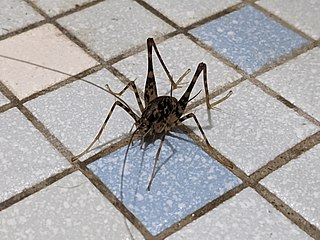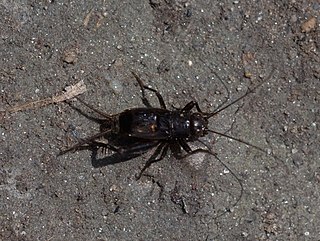
The orthopteran family Rhaphidophoridae of the suborder Ensifera has a worldwide distribution. Common names for these insects include cave crickets, camel crickets, spider crickets, and sand treaders. Those occurring in New Zealand are typically referred to as jumping or cave wētā. Most are found in forest environments or within caves, animal burrows, cellars, under stones, or in wood or similar environments. All species are flightless and nocturnal, usually with long antennae and legs. More than 500 species of Rhaphidophoridae are described.

Diestrammena is a 'camel' or 'cave-cricket' genus in the family Rhaphidophoridae. Species in the genus are native to Asia, including Japan.

Meconematinae is a subfamily of the bush crickets, with a worldwide distribution.
Tachycines (Gymnaeta) bifurcatus is a species of camel cricket in the Aemodogryllinae subfamily. This species was first described in 2010 by Gorochov, under its synonym Diestrammena bifurcata.

Pteronemobius is a genus of crickets in the subfamily Nemobiinae, with a worldwide distribution.
Anabropsis is a genus of king crickets in the tribe Anabropsini. They are found tropical areas of the Americas, Africa and Asia.
The subfamily Rhaphidophorinae contains the single tribe of camel crickets, the Rhaphidophorini, based on the type genus Rhaphidophora.
Rhaphidophora is the type genus of camel crickets in the tribe Rhaphidophorini.
Diestramima is a genus of camel crickets in the subfamily Aemodogryllinae and tribe Diestramimini. Species can be found in: India, southern China and Indo-China.
Gigantettix is a genus of camel crickets in the subfamily Aemodogryllinae and tribe Diestramimini. The type species, from Vietnam, was originally assigned to the genus Diestramima ; subsequently, other species have been found in the Indo-China region.

Kuzicus is a genus of Asian bush crickets belonging to the tribe Meconematini in the subfamily Meconematinae.
Xizicus is a genus of Asian bush crickets belonging to the tribe Meconematini in the subfamily Meconematinae. They are found in India, China, Korea, and Indochina.

Tachycines is a genus of camel crickets in the subfamily Aemodogryllinae and tribe Aemodogryllini. Some authorities had placed the type species, T. asynamorus, in the genus Diestrammena, but recent papers returned this to the subgenus Tachycines (Tachycines), with a substantial number of new species recently described.
Eutachycines is a genus of cave or camel crickets in the subfamily Aemodogryllinae and tribe Aemodogryllini. Originating in Asia, species have been found in Sri Lanka, southern China, Indo-China and west Malesia.
Microtachycines is a genus of cave or camel crickets in the subfamily Aemodogryllinae and tribe Aemodogryllini. The type species name M. tamdaonensis is based on specimens found in Tam Dao National Park in Vietnam.
Paradiestrammena is a genus of cave or camel crickets in the subfamily Aemodogryllinae and tribe Aemodogryllini. Originating in Asia, species have been found in Borneo, the Indo-China region and Japan.
Tamdaotettix is a genus of cave or camel crickets in the subfamily Aemodogryllinae and tribe Diestramimini. Originating in Asia, species have been found in the Indo-China region.
Adiestramima is a genus of cave or camel crickets in the subfamily Aemodogryllinae and tribe Diestramimini. Originating in Asia, species have been found in the Indo-China region, mostly Vietnam.
Megadiestramima is a genus of cave or camel crickets in the subfamily Aemodogryllinae and tribe Diestramimini. Originating in Asia, species have been found in the Indo-China region.
Apterolarnaca is a genus of Orthopterans, sometimes known as 'leaf-folding crickets' in the subfamily Gryllacridinae, tribe Ametrini and genus group ApotrechaeCadena-Castañeda, 2019. Records of occurrence are from southern China and Vietnam.





